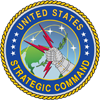Fact Sheets
- Fact Sheets Home
- Command Snapshot
- Mission Areas:
- Cyber Command
- Global Strike
- Space
- - JNWC
- IMD
- ISR
- JSpOC
- HSFS (Det 3, 45OG)
- TBMW
- SCC-WMD
- - PSI
United States Strategic Command (USSTRATCOM)
Senior Leadership:
| Commander: | General C. Robert "Bob" Kehler |
| Deputy Commander: | Vice Admiral Tim Giardina |
| Chief of Staff: | Major General William Grimsley |
| Command Senior Enlisted Leader: | Command Sergeant Major Patrick Z. Alston |
Mission Statement:
Detect, deter, and prevent attacks against the United States and our allies - join with the other combatant commands to defend the nation should deterrence fail.
Headquarters Organizational Structure
J1 - Manpower & Personnel - Colonel Caroline M. Miller: Develops and administers command manpower and personnel policies, human resources, and personnel assignment programs.
J2 - Intelligence - Brigadier General Mark W. Westergren: Responsible for delivering all-source intelligence while enabling the execution of assigned strategic deterrence, space and cyberspace operations. Directs all intelligence-related support for the Commander and ensures unity of intelligence effort across the Command.
J3 - Global Operations - Major General Gregory A. Biscone: Coordinates the planning, employment and operation of DoD strategic assets and combines all current operations, intelligence, and global command and control operations. Subdivisions within J3 include Combat and Information Operations, Current Operations, Logistics, and Joint Exercises and Training.
J5 - Plans and Policy - Major General John W. Raymond: Responsible for coordinating the development and implementation of national security policy as it applies to the command and the execution of its mission. Develops future plans, policy and strategy across all mission areas as outlined in the Unified Command Plan.
J6 - C4 Systems - Ms. Kerry E. Kelley, SES: Coordinates, facilitates, monitors and assesses systems, networks and communications requirements.
J8 - Capability and Resource Integration - Mr. Kenneth S. Callicutt, SES: Conducts force management and analysis to include integrating, coordinating, prioritizing, and advocating USSTRATCOM future concepts, mission capability needs, weapons system development, support for emerging technologies, and command and control architecture across the mission areas. Responsible for all command requirement processes, and ensures appropriate decision support tools and assessment processes are in place to enhance operational capabilities.
J9 - Mission Assessment and Analysis - Mr. Jerry L. Gandy, SES: Enhances the commander's decision space through mission assessments that identify risks and alternative futures analyses that illuminate an expanded range of options for strategic decisions.
J10 - Joint Reserve Directorate - Major General William F. Schauffert: The Joint Reserve Directorate advises CDRUSSTRATCOM and staff on matters related to the Army, Air Force, Navy, and Marine Corps Reserve personnel assigned to USSTRATCOM. The J10 coordinates Reserve funding requests with the applicable service.
Component Structure:
U.S. Strategic Command's day-to-day planning and execution for the primary mission areas is done by a sub-unified command (USCYBERCOM) and the following USSTRATCOM components:
U.S. Cyber Command Ft. Meade, MD – USCYBERCOM plans, coordinates, integrates, synchronizes, and conducts activities to: direct the operations and defense of specified Department of Defense information networks and; prepare to, and when directed, conduct full-spectrum military cyberspace operations in order to enable actions in all domains, ensure US/Allied freedom of action in cyberspace and deny the same to our adversaries. (more)
JFCC - Global Strike (JFCC-GS) Offutt AFB, NE – Conducts kinetic (nuclear and conventional) and non-kinetic effects planning. GS manages global force activities to assure allies and to deter and dissuade actions detrimental to the United States and its global interests; should deterrence fail, employs global strike forces in support of combatant commander. (more)
JFCC - Space (JFCC-Space) Vandenberg AFB, CA – Continuously coordinates, plans, integrates, commands and controls space operations to provide tailored, responsive, local and global effects, and on order, denies the enemy the same, in support of national, USSTRATCOM, and combatant commander objectives. (more)
JFCC - Integrated Missile Defense (JFCC-IMD) Schriever AFB, CO – Synchronizes operational-level global missile defense planning, operations support, and the development of missile defense effects for DoD. When directed, also provides alternate missile defense execution support. (more)
JFCC - Intelligence, Surveillance and Reconnaissance (JFCC-ISR) Bolling AFB, Washington, D.C. – Identifies and recommends appropriate resources to meet high priority intelligence requirements. Essentially, ISR helps ensure the best use of resources to provide decision makers and troops with crucial information when and where they need. (more)
USSTRATCOM Center for Combating Weapons of Mass Destruction (SCC-WMD) Fort Belvoir, VA – Provides the Defense Department with expertise in contingency and crisis planning to interdict and eliminate the proliferation or use of Weapons of Mass Destruction. (more)
Joint Warfare Analysis Center (JWAC) Dahlgren, VA – The Joint Warfare Analysis Center (JWAC) provides combatant commands, Joint Staff, and other customers with precise technical solutions in order to carry out the national security and military strategies of the United States. JWAC maintains and enhances its ability to conduct comprehensive technical analysis.
Personnel Requirements:
Military: 2,033
Civilian: 2,057
Contact Information:
U.S. Strategic Command, Public Affairs Office (J020)
901 SAC Blvd., Suite 1A1
Offutt AFB, NE 68113-6020
Phone: DSN 271-4130 or (402) 294-4130
Fax: (402) 294-4892
Current as of December 2011
